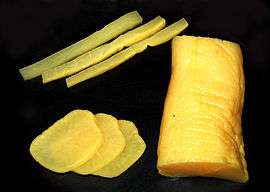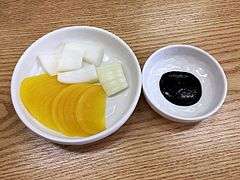Takuan
Takuan (Japanese: 沢庵; also spelled takuwan), or takuan-zuke (沢庵漬け; 'pickled takuan'), known as danmuji (단무지) in the context of Korean cuisine,[1][2] is a pickled preparation of daikon radish. As a popular part of traditional Japanese cuisine, takuan is often served uncooked alongside other types of tsukemono ('pickled things'). It is also enjoyed at the end of meals as it is thought to aid digestion.

History
In Japan, Takuan Sōhō is credited with concocting this yellow pickle, which now bears his name.[3]
Usage
.jpg)
Usually, takuan is washed with water to remove excess brine and then sliced thinly before serving. It is eaten as a side dish during meals, and eaten as a snack at teatime. Strip-cut takuan is often used for Japanese bento. Traditional takuan—using daikon radish that has been sun-dried and then pickled in a rice bran bed—is sometimes stir-fried or braised when getting older and sour. Some sushi rolls use strip-cut takuan for ingredients, e.g. shinkomaki (takuan only) and torotaku-maki (maguro [fatty tuna] and takuan).
In Korea
Takuan is called danmuji (단무지) in Korea. Danmuji is a common banchan (side dish) served with bunsik (light meal or snack), as well as with Korean Chinese dishes.
Production
In the traditional process of making takuan, the first step is to hang a daikon radish in the sun for a few weeks by the leaves until it becomes dehydrated and flexible. Next, the daikon is placed in a pickling crock and covered with a mixture of salt, rice bran, optionally sugar, daikon greens, kombu, and perhaps chilli pepper and/or dried persimmon peels. A weight is then placed on top of the crock, and the daikon is allowed to pickle for several months. The finished takuan is usually yellow in color and quite pungent.
Most mass-produced takuan uses salt or syrup to reduce the dehydration time and artificial color to enhance the appearance.
Iburi-gakko (lit. 'smoked takuan') is eaten in Akita Prefecture in the North. It is smoked rather than sun-dried before pickling.
Gallery
 Sliced Takuan
Sliced Takuan Raw onion, danmuji, and chunjang (sweet bean sauce) are typically served in Korean Chinese restaurants
Raw onion, danmuji, and chunjang (sweet bean sauce) are typically served in Korean Chinese restaurants
See also
- Nukazuke – Japanese pickle made by fermenting vegetables in rice bran
- Pickled radish – A radish dish served with Korean fried chicken
- List of foods named after people – Wikipedia list article
- List of pickled foods – List of links to Wikipedia articles on pickled foods
References
| Wikimedia Commons has media related to Takuan. |
- Sula, Mike (22 January 2009). "Omnivorous: Black Noodles and Other Delights". Chicago Reader. Retrieved 5 September 2017.
- Surh, Jeonghee; Kim, Young-Kyung Lee; Kwon, Hoonjeong (2008). "Korean Fermented Foods: Kimchi and Doenjang". In Farnworth, Edward R. (ed.). Handbook of Fermented Functional Foods (Second ed.). Boca Raton: CRC Press. p. 336. ISBN 978-1-4200-5326-5.
- Nagamura, Kit. "All at sea in Shinagawa". The Japan Times Online. October 5, 2007. Accessed July 11, 2011.
External links
Tokyo Central Pickle Co., Ltd. Histry of Takuan, Variation Of Takuan.